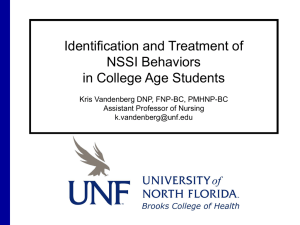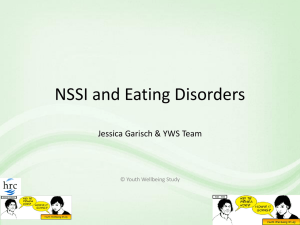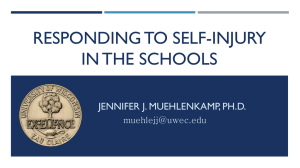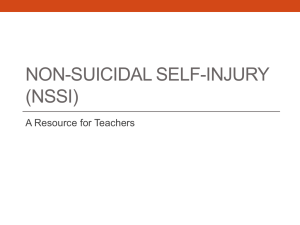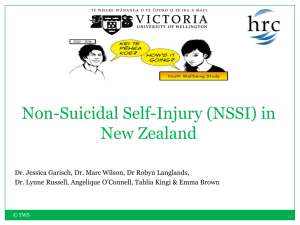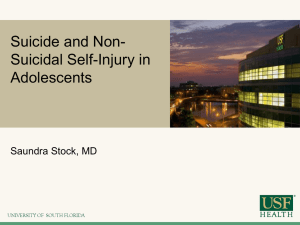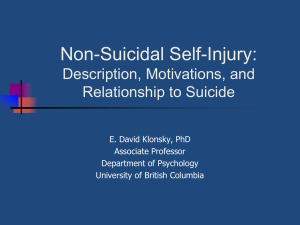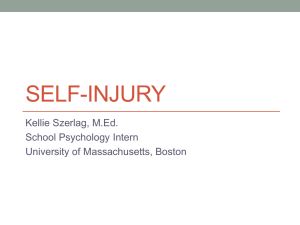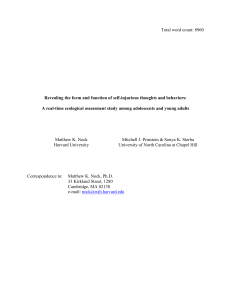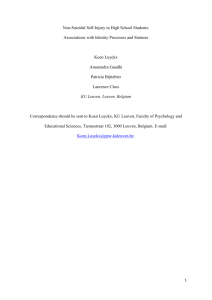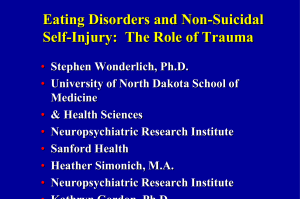Nock_NewInsights_Selfinjury
advertisement
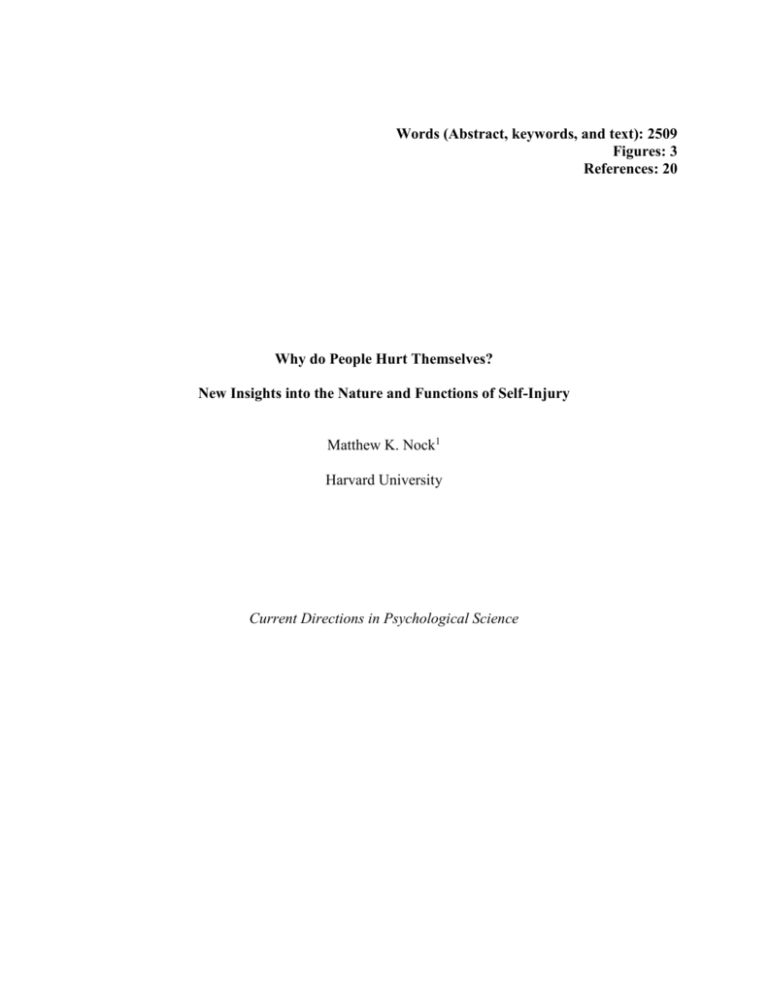
Words (Abstract, keywords, and text): 2509 Figures: 3 References: 20 Why do People Hurt Themselves? New Insights into the Nature and Functions of Self-Injury Matthew K. Nock1 Harvard University Current Directions in Psychological Science Why do people hurt themselves? 2 ABSTRACT Non-suicidal self-injury (NSSI) is a prevalent but perplexing behavior problem in which people deliberately harm themselves without lethal intent. Research on the nature of NSSI reveals that it typically has its onset during early adolescence, most often involves cutting or carving the skin, and appears equally prevalent across sexes, ethnicities, and socioeconomic statuses. Less is known about why people engage in NSSI. This paper presents a theoretical model of the development and maintenance of NSSI. Rather than a symptom of mental disorder, NSSI is conceptualized as a harmful behavior that can serve several intrapersonal (e.g., affect regulation) and interpersonal (e.g., help-seeking) functions. Risk of NSSI is increased by general factors that contribute to problems with affect regulation or interpersonal communication (e.g., childhood abuse), and by specific factors that influence the decision to use NSSI rather than some other behavior to serve these functions (e.g., social modeling). This model synthesizes research from several different areas of the literature and points toward several lines of research needed to further advance the understanding of why people hurt themselves. KEYWORDS: self-injury; self-harm; self-mutilation; suicide; function Why do people hurt themselves? 3 Humans are imbued with a drive for survival; yet, we often do things that impede this drive. Suicide is the most extreme case. In less extreme instances, people deliberately injure themselves without wanting to die. Reports of such behavior have appeared for thousands of years; however, there appears to have been a dramatic increase in this perplexing behavior over the past few decades. Recent findings from psychological science have provided new insights into the nature and functions of this perplexing behavior. WHAT IS NON-SUICIDAL SELF-INJURY? Non-suicidal self-injury (NSSI) is the direct, deliberate destruction of one’s own body tissue in the absence of intent to die. These features distinguish it from behavior whose harmful consequences are unintended (e.g., lung cancer from smoking), and from suicidal behavior whose prevalence, correlates, course, and response to treatment differ. Culturally sanctioned bodily modification, such as tattooing or body piercing, is not classified as NSSI. Approximately 1%-4% of adults and 13%-23% of adolescents report a lifetime history of NSSI (Jacobson & Gould, 2007). The higher rates among adolescents suggest that either the rate of NSSI is increasing or that there are reporting biases among adults causing them to deny their history of NSSI, or both. NSSI most often involves cutting oneself with a knife or razor, typically begins in early adolescence, occurs among people with a wide range of psychiatric disorders (and in some cases in those with no disorder), is associated with an increased risk of suicide attempt, and does not appear to differ as a function of sex, ethnicity, or socioeconomic status (Hilt, Nock, Lloyd-Richardson, & Prinstein, 2008; Nock, Joiner, Gordon, LloydRichardson, & Prinstein, 2006). Despite the prevalence of NSSI, little is known about why people engage in this behavior. Why do people hurt themselves? 4 WHY DO PEOPLE HURT THEMSELVES? Many theoretical models of NSSI have been proposed. Psychodynamic theorists suggest that NSSI is performed to master sexual penetration or death. Folk explanations invoke concepts like manipulation, impulsiveness, and low self-esteem. Empirical work on NSSI has aimed at identifying correlates of this behavior, with childhood abuse and psychiatric disorders emerging most consistently in the literature. The strong relation between psychiatric disorders and NSSI has led many to conceptualize NSSI as a symptom of a psychiatric disorder. However, such a perspective is unsatisfying given that NSSI occurs across many disorders and is not symptomatic of any one disorder (Nock et al., 2006). Moreover, suggesting that people engage in NSSI because it is a symptom of a disorder provides little explanatory power. This article presents an alternative explanation for the development and maintenance of NSSI. The proposed theoretical model integrates findings from several different areas of the literature, explains why factors such as childhood abuse and psychiatric disorders are associated with NSSI, and highlights new questions and directions for research on this topic. This model proposes that (a) NSSI functions both as a means of regulating one’s emotional/cognitive experiences and communicating with or influencing others, (b) risk for NSSI is increased by the presence of distal risk factors (e.g., childhood abuse) that contribute to problems with affect regulation and interpersonal communication, and (c) several more specific factors (e.g., social modeling) explain why some people use NSSI in particular to serve these functions (see Figure 1). What are the Functions of NSSI? A functional approach assumes that behaviors are determined by their immediate antecedents and consequents. By focusing on local determinants, this approach cannot account Why do people hurt themselves? 5 for the full range of causal factors that influence a behavior. Nevertheless, research using a functional perspective has led to significant advances in the understanding and treatment of various forms of psychopathology including depression, anxiety, substance use, and child conduct problems (e.g., Hayes, Wilson, Gifford, Follette, & Strosahl, 1996). Applying a functional approach to NSSI, it is suggested that this behavior is maintained by several reinforcement processes: intrapersonal-negative reinforcement (i.e., NSSI decreases or distracts from aversive thoughts or feelings), intrapersonal-positive reinforcement (i.e., NSSI generates desired feelings/stimulation), interpersonal-positive reinforcement (i.e., NSSI facilitates help-seeking), or interpersonal-negative reinforcement (i.e., NSSI facilitates escape from undesired social situations). Several lines of research provide empirical evidence for each of these four processes. First, experimental studies among people with developmental disabilities have shown that applying and removing desired and aversive stimuli immediately following NSSI increases or decreases this behavior in patterns consistent with the functional model outlined above (e.g., Iwata et al., 1994). Second, studies among typically developing adolescents and adults have demonstrated that the reasons self-injurers cite as motives for their NSSI fit closely (e.g., in confirmatory factor analyses) with the four-function model (Nock & Prinstein, 2004) and that the four functions correlate in expected ways with other clinical constructs (see Nock & Prinstein, 2005). Third, studies have supported hypotheses derived directly from this model. For instance, self-injurers show decreases in physiological arousal following imaginary exposure to NSSI (Haines, Williams, Brain, & Wilson, 1995) and improvements in familial relationships following engagement in NSSI (Hilt, Nock et al., 2008). Although these studies provide information about the functions served by NSSI, they do not Why do people hurt themselves? 6 address the etiologic question of why some people experience the affective and social dysregulation that serves as antecedents to NSSI. What Factors Increase the Risk of NSSI? The proposed model suggests that some people develop intra- or interpersonal vulnerabilities that predispose them to respond to challenging or stressful events with affective or social dysregulation, creating a need to use NSSI or some other extreme behavior to modulate their affective or social experience. Preliminary evidence for such vulnerabilities comes from laboratory-based studies far removed from the context of an episode of NSSI, supporting their role as trait-like vulnerability factors. For instance, relative to non-injurers, self-injurers display elevated physiological arousal (skin conductance) in response to a laboratory-based stressor (Figure 2), and this effect is especially pronounced for those who report that they engage in NSSI in response to high aversive arousal (Nock & Mendes, 2008). Self-injurers also elect to discontinue/escape this task significantly sooner than non-injurers (Nock & Mendes, 2008), and report greater efforts to suppress aversive thoughts and feelings in their everyday life (Najmi, Wegner, & Nock, 2007). Most of this work has focused on intrapersonal correlates of NSSI; however, evidence for interpersonal vulnerability factors has been revealed in studies showing deficits in social problem-solving and communication among self-injurers (Hilt, Cha, & NolenHoeksema, 2008; Nock & Mendes, 2008). These vulnerability factors are believed to be caused by more distal risk factors such as childhood abuse and genetic predispositions to high emotion reactivity. For instance, childhood maltreatment is associated with subsequent neurobiological abnormalities characterized by reduced activity in the frontal cortex and an increased stress response (e.g., Kaufman & Charney, 2001). Such abnormalities represent a pathway through which childhood abuse may lead to Why do people hurt themselves? 7 increased emotional reactivity and an inability to manage such a response, which is then (maladaptively) managed using NSSI. Factors such as childhood abuse also can preclude the developing child from learning effective social problem-solving or communication skills, thus contributing to the interpersonal vulnerabilities mentioned above. Of course, these vulnerability factors are not specific to NSSI and have been shown to increase the risk of a number of psychiatric disorders. This model suggests that NSSI is related to psychiatric disorders because they share these etiologic pathways. In fact, when factors such as high emotional/physiological reactivity are statistically controlled, childhood abuse (Weierich & Nock, 2008) and psychiatric disorders (Nock, Wedig, Holmberg, & Hooley, 2008) are no longer associated with NSSI. If NSSI and some psychiatric disorders share an etiologic pathway and represent different forms of behavior that can serve the same function, one is left wondering why some people select NSSI rather than another pathological behavior to regulate their affective and social experiences. Why Use NSSI to Serve these Functions? There are many non-injurious ways to regulate emotions (e.g., exercise, alcohol) or communicate with others (e.g., talking, gesturing). So why use NSSI? Below I present several specific processes proposed to increase the likelihood that a person will use NSSI to serve these functions. These hypothesized processes each have preliminary empirical support and represent some of the most intriguing current directions for NSSI research. Social learning hypothesis. The decision to engage in NSSI undoubtedly is influenced by observing the behavior being used by others. Indeed, most self-injurers report first learning about the behavior from friends, family, and the media. Interestingly, there has been a sharp increase in references to NSSI in movies, songs, print media, and the internet over the past Why do people hurt themselves? 8 decade (Whitlock, Purington, & Gershkovich, in press), which may help explain the apparent increase in this behavior over the same period. Self-punishment hypothesis. Self-punishment or self-deprecation also may motivate NSSI, with NSSI representing a form of self-directed abuse learned via repeated abuse or criticism by others. This would explain further how and why childhood abuse is associated with NSSI. Recent research supports this hypothesis by showing that the relation between childhood abuse and NSSI is mediated by adolescent self-criticism (Glassman, Weierich, Hooley, Deliberto, & Nock, 2007). Moreover, many people endorse self-punishment as a primary motivator for NSSI (Nock & Prinstein, 2004). Social signaling hypothesis. NSSI can be especially effective as a means of social communication and influence precisely because it is a harmful, and thus costly, behavior (Hagen, Watson & Hammerstein, in press; Nock, 2008). As demonstrated in research on animal communication, costly behaviors are much more likely to be believed (“honest signals”) because otherwise they would not be performed. Translating this principle to humans, high cost behaviors (e.g., NSSI) are more likely to elicit desired responses from others than low cost behaviors (e.g., talking). NSSI may develop among those for whom other communication strategies have failed due to poor quality or clarity, or when less costly behaviors have not produce the desired effect due to an unresponsive or invalidating environment (Wedig & Nock, 2007). Pragmatic hypothesis. Perhaps the most parsimonious explanation for why some people choose NSSI is that it is a relatively fast and easily accessible method of serving the proposed functions. NSSI can be performed quickly in virtually any context and does not require the time and materials involved in other behaviors that may serve a similar function (e.g., exercise, Why do people hurt themselves? 9 alcohol), making it an attractive behavior for adolescents and young adults who lack the executive control to regulate their emotions and behavior and who may not have ready access to alcohol or drugs. Pain analgesia/opiate hypothesis. It also is important to consider what stops some people at risk for NSSI from engaging in this behavior: the pain involved in the act. Interestingly, self-injurers report little or no pain during NSSI and show pain analgesia on labbased tests of pain tolerance. It is unclear if this pain analgesia is a dispositional factor perhaps resulting from elevated levels of endorphins in the body, emerges via habituation as a result of earlier abuse, or is a by-product of the release of endogenous opiates that results from repeated NSSI. This finding has been reported consistently across studies of NSSI and represents one of the most intriguing directions for future research on this topic. Implicit identification hypothesis. As a result of these influences, some people may come to identify with NSSI and value it as an effective means of achieving one of the functions described. This identification may foster selection of this behavior over other behaviors, thereby maintaining it. For instance, when I want to regulate my emotions (e.g., decrease anxiety), I do not smoke cigarettes because I am not a smoker, instead I go for a run because I see myself as a runner, perhaps because that behavior has served me well when attempting to regulate my emotions in the past. In the same way, some people may select NSSI because they identify with this behavior. Consistent with this view, we recently demonstrated that self-injurers hold a stronger implicit identification with self-injury than do non-injurers, as shown by their performance on the Implicit Association Test—a brief, computerized, reaction time test of the associations people hold about different constructs (Figure 3a)(Nock & Banaji). Interestingly, a similar identification with self-injury emerged among those with suicidal thoughts, with an Why do people hurt themselves? 10 especially strong identification among those making suicide attempts (Figure 3b)(Nock & Banaji, 2007b). It is not yet clear if implicit identification with self-injury influences the initial decision to use the behavior or develops as a result of the behavior. This represents one key question for future research. FUTURE DIRECTIONS Recent research has answered many of the basic questions about this perplexing behavior, but many important questions and exciting directions remain. First, the evidence for the apparent increase in NSSI comes largely from anecdotal reports and estimates from small cross-sectional studies. Epidemiologic and longitudinal studies are needed to provide more accurate estimates of the base rate, trends, and long-term course of NSSI. Second, most of the evidence for the etiology of NSSI is from cross-sectional or retrospective studies. Research examining factors influencing the development of NSSI will increase the understanding of this behavior and improve prevention efforts. Third, although a consensus is emerging on the functions of NSSI, the mechanisms through which NSSI influences affective and social events remain unknown. For instance, although it is clear that NSSI results in decreased negative affect, it is unclear if this occurs via the release of endorphins, distraction from the distressing thought/feeling, or some other process. Fourth, most studies have relied on retrospective selfreport of NSSI or experimental manipulation of hypothesized processes in the laboratory. Studies examining episodes of this behavior as it occurs in nature, such as those using ambulatory monitoring devices, are sorely needed. Fifth, although it has been proposed that NSSI and other potentially harmful serve similar functions, few studies have carefully examined the co-occurrence of these different behaviors—a necessary step in testing this conceptualization. Sixth, initial evidence suggests that family and cultural factors influence NSSI, offering an Why do people hurt themselves? 11 important direction for additional investigation. Finally, there are currently no evidence-based treatments for NSSI. Efforts to prevent and treat NSSI may be most effective and efficient with the incorporation of recent findings from psychological science. Why do people hurt themselves? 12 Notes 1 Address correspondence to Matthew Nock, Harvard University, Department of Psychology, 33 Kirkland Street, 1280, Cambridge, MA 02138; e-mail: nock@wjh.harvard.edu. Acknowledgement The writing of this paper was supported by funding from the National Institute of Mental Health (MH077883). Thanks to Richard McNally, Jill Hooley, Irene Janis, and Christine Cha for providing helpful comments on an earlier draft of this paper. Recommended Readings Favazza, A. R. (1996). Bodies under siege: Self-mutilation and body modification in culture and psychiatry (2nd ed.). Baltimore, MD: Johns Hopkins University Press. The seminal book on this topic; presents a comprehensive historical, anthropological, and clinical review of NSSI. Hooley, J. M. (2008). Self-harming behavior: Introduction to the special series on non-suicidal self-injury. Applied and Preventive Psychology, 12, 155-158. Introduction to a special issue of this journal with each article providing an empirically-based theoretical review of some aspect of why people hurt themselves and how to prevent these behaviors. Klonsky, E. D. (2007). Non-suicidal self-injury: an introduction. Journal of Clinical Psychology, 63(11), 1039-1043. A special issue devoted to NSSI; provides brief literature reviews geared primarily toward practicing clinicians. Why do people hurt themselves? 13 Nock, M. K. (Ed.). (in press). Understanding non-suicidal self-injury: Origins, assessment, and treatment. Washington, D.C.: American Psychological Association. A comprehensive edited volume on NSSI geared toward researchers, scholars, and clinicians. Prinstein, M. J. (2008). Introduction to the special section on suicide and non-suicidal self-injury: A review of unique challenges and important directions for self-injury science. Journal of Consulting and Clinical Psychology, 76(1), 1-8. A special issue of this journal devoted to NSSI and suicidal behavior that contains representative original research on this topic. Why do people hurt themselves? 14 REFERENCES Glassman, L. H., Weierich, M. R., Hooley, J. M., Deliberto, T. L., & Nock, M. K. (2007). Child maltreatment, non-suicidal self-injury, and the mediating role of self-criticism. Behaviour Research and Therapy, 45(10), 2483-2490. Hagen, E. H., Watson, P., & Hammerstein, P. (in press). Gestures of despair and hope: A view on deliberate self-harm from economics and evolutionary biology. Biological Theory. Haines, J., Williams, C. L., Brain, K. L., & Wilson, G. V. (1995). The psychophysiology of selfmutilation. Journal of Abnormal Psychology, 104(3), 471-489. Hayes, S. C., Wilson, K. G., Gifford, E. V., Follette, V. M., & Strosahl, K. (1996). Experimental avoidance and behavioral disorders: a functional dimensional approach to diagnosis and treatment. Journal of Consulting and Clinical Psychology, 64(6), 1152-1168. Hilt, L. M., Cha, C. B., & Nolen-Hoeksema, S. (2008). Non-suicidal self-injury in young adolescent girls: Moderators of the distress-function relationship. Journal of Consulting and Clinical Psychology, 76(1), 63-71. Hilt, L. M., Nock, M. K., Lloyd-Richardson, E., & Prinstein, M. J. (2008). Longitudinal study of non-suicidal self-injury among young adolescents: Rates, correlates, and preliminary test of an interpersonal model. Journal of Early Adolescence, 28, 455-469. Iwata, B. A., Pace, G. M., Dorsey, M. F., Zarcone, J. R., Vollmer, T. R., Smith, R. G., et al. (1994). The functions of self-injurious behavior: An experimental-epidemiological analysis. Journal of Applied Behavior Analysis, 27(2), 215-240. Kaufman, J., & Charney, D. (2001). Effects of early stress on brain structure and function: Implications for understanding the relationship between child maltreatment and depression. Development and Psychopathology, 13(3), 451-471. Why do people hurt themselves? 15 Najmi, S., Wegner, D. M., & Nock, M. K. (2007). Thought suppression and self-injurious thoughts and behaviors. Behaviour Research and Therapy, 45, 1957-1965. Nock, M. K. (2008). Actions speak louder than words: An elaborated theoretical model of the social functions of self-injury and other harmful behaviors. Applied and Preventive Psychology. Nock, M. K., & Banaji, M. R. (2007a). Assessment of self-injurious thoughts using a behavioral test. American Journal of Psychiatry, 164(5), 820-823. Nock, M. K., & Banaji, M. R. (2007b). Prediction of suicide ideation and attempts among adolescents using a brief performance-based test. Journal of Consulting and Clinical Psychology, 75(5), 707-715. Nock, M. K., Joiner, T. E., Jr., Gordon, K. H., Lloyd-Richardson, E., & Prinstein, M. J. (2006). Non-suicidal self-injury among adolescents: Diagnostic correlates and relation to suicide attempts. Psychiatry Research, 144(1), 65-72. Nock, M. K., & Mendes, W. B. (2008). Physiological arousal, distress tolerance, and social problem-solving deficits among adolescent self-injurers. Journal of Consulting and Clinical Psychology, 76(1), 28-38. Nock, M. K., & Prinstein, M. J. (2004). A functional approach to the assessment of selfmutilative behavior. Journal of Consulting and Clinical Psychology, 72(5), 885-890. Nock, M. K., & Prinstein, M. J. (2005). Clinical features and behavioral functions of adolescent self-mutilation. Journal of Abnormal Psychology, 114(1), 140-146. Nock, M. K., Wedig, M. M., Holmberg, E. B., & Hooley, J. M. (2008). Emotion reactivity scale: Psychometric evaluation and relation to self-injurious thoughts and behaviors. Behavior Therapy, 39, 107-116. Why do people hurt themselves? 16 Wedig, M. M., & Nock, M. K. (2007). Parental expressed emotion and adolescent self-injury. Journal of the American Academy of Child and Adolescent Psychiatry, 46(9), 1171-1178. Weierich, M. R., & Nock, M. K. (2008). Posttraumatic stress symptoms mediate the relation between childhood sexual abuse and non-suicidal self-injury. Journal of Consulting and Clinical Psychology, 76(1), 39-44. Whitlock, J., Purington, A., & Gershkovich, M. (in press). Media and the internet and nonsuicidal self-injury. In M. K. Nock (Ed.), Understanding non-suicidal self-injury: Origins, assessment, and treatment. Washington, DC: American Psychological Association. Why do people hurt themselves? 17 Figure captions Figure 1. An integrated theoretical model of non-suicidal self-injury. Figure 2. Change in skin conductance level (SCL) during a distressing/frustrating cardsorting task for those with a recent history of NSSI (n = 62) compared to a non-injurious control group (n = 30). The NSSI group shows significantly higher physiological arousal than the non-injurious group. The full study is report in Nock & Mendes (2008). Figure 3. (A) Results of an Implicit Association Test (IAT) that measures the strength of associations people hold between self-injury (represented by images of cut skin versus images of non-cut skin) and the self (represented by words related to the self [“I,” “mine,” “me”] versus words related to others [“they,” “them,” “their”]). Positive scores on this test represent a stronger association between self-injury and the self (i.e., faster responding on a computer based test when self-injury and the self are paired on the same computer key), and negative scores represent a stronger association between non-injury and the self. The difference between self-injurers and non-injurers is large and statistically significant. (B) Results of the same IAT but with comparisons between those who are non-suicidal, those who have thoughts of suicide, and those who made a recent suicide attempt (regardless of NSSI status). The differences between each of the three groups are large and statistically significant. The full studies are reported in (Nock & Banaji, 2007a & b). Figure 1. Integrated Theoretical Model of the Development and Maintenance of NSSI Regulation of affective experience Distal Risk Factors Genetic predisposition for high emotional/ cognitive reactivity Childhood abuse/ maltreatment Familial hostility/ criticism Intrapersonal Vulnerability Factors High aversive emotions High aversive cognitions Poor distress tolerance Interpersonal Vulnerability Factors Stress Response Stressful event triggers over- or under-arousal or Stressful event presents unmanageable social demands X NSSI-Specific Vulnerability Factors Social learning hypothesis Self-punishment hypothesis Social signaling hypothesis Pragmatic hypothesis Pain analgesia/ opiate hypothesis Implicit identification hypothesis Poor communication skills Poor social problem-solving Regulation of social situation NSSI Why do people hurt themselves? 19 Figure 2. Change in SCL 2.5 NSSI 2 Control 1.5 1 0.5 0 -0.5 -1 2 4 6 8 Minutes 10 12 14 Figure 3. A Standardized D -Score on SI-IAT 0.3 0.2 0.1 0 -0.1 -0.2 -0.3 -0.4 No NSSI (n =36) Standardized D- Score on SI-IAT B NSSI (n =53) 0.6 0.4 0.2 0 -0.2 -0.4 Non-Suicidal (n =38) Suicidal Ideation (n =37) Suicide Attem pt (n =14)
